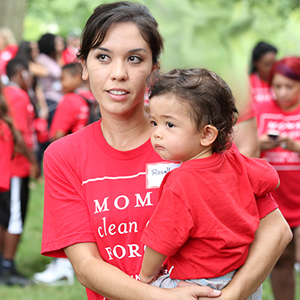This resource has been factchecked by policy experts, using the latest scientific research. Find all our sources linked below.
Preparedness, Safety, and Clean Up
Climate change is affecting the intensity and frequency of precipitation, increasing flooding across the country year-round. Typically, flooding is the result of prolonged rainfall over several days or happens when copious rain falls over a short period. Water accumulates faster than soil or rivers can absorb it. As climate change alters precipitation patterns, the threat of flooding, including storm surge, may increase in the coming years.
While flash floods come on quickly, some flooding is more predictable. The best way to protect yourself, your family, and your home from floods is to prepare in advance, know what to do during a flood, and work quickly after floodwater recedes to avoid disease from standing water plus mold that thrives in moist environments.

What to do before a flood: Preparation
Having a set plan can protect property and safeguard health. Here’s how to prepare:
- Sign up for National Weather Service flooding alerts and warnings, plus regional ones.
- Understand your risk. Coastal or low-lying areas are at highest risk, but flooding occurs inland too.
- If you live in a risky area, make sure your sump pump is working—or install one—and prepare sandbags. Renters can work with their landlords.
- Gather at least three days’ worth of emergency supplies, including water and food for your family and pets. Include medicines, batteries, flashlights, and a radio. Learn more about assembling an emergency kit here: www.ready.gov/kit
- Create a personal evacuation plan and familiarize yourself with any community plans.
- Check with your insurance company about coverage for possible damage. Most home and renters’ insurance policies don’t cover flooding. The National Flood Insurance Program can be a resource: www.floodsmart.gov
- In the event of a flood warning, fill your car’s gas tank, charge all electronics, and secure outdoor items like grills and furniture.
- In case of evacuation, turn off your main power switch and close the main gas valve.
What to do during a flood: Stay safe
Heed all flooding alerts and warnings. Never ever drive or walk into floodwater. The National Weather Service says more deaths occur yearly because of flooding than any other thunderstorm-related hazard. Most flood-related drowning occurs when people drive into floodwater. Just 12 inches of rushing water can carry away most cars. People also drown when walking near or into floodwater. Six inches of fast-moving water can knock down an adult. In addition, floodwater can contain chemical hazards and spread infectious disease. Downed power lines are also a hazard.

What to do after a flood: Clean up
Approximately 75% of all presidential disaster declarations are associated with flooding. Disaster or not, cleaning up after a flood is rife with possible hazards—and stressful.
Whether you’ve sheltered in place or have been displaced by flooding and then cleared by authorities to move back home, time is of the essence. Here are general post-flood cleanup steps:
- Never drink floodwater or use it to wash or prepare food or brush teeth. Follow local advisories about water safety.
- If electricity is out, use generators and other machines away from doors, windows, and vents to prevent carbon monoxide poisoning.
- To avoid mold growth, dry out any flooded areas within 48 hours.
- Rent industrial dehumidifiers or hire a remediation company that has them to help with drying damp areas. Fans are also useful.
- Practice safe cleaning. Wear gloves, protective clothing, boots, goggles, and an N95 mask to protect yourself from possible bacteria, viruses, and mold spores. People with asthma, allergies, or other breathing problems may choose to let others clean.
- Don’t mix bleach with other cleaning products. Do open windows for ventilation as you clean.
- Throw unsafe items away. Toss improperly refrigerated food in case of power loss and anything that came into contact with floodwater or possibly sewage that cannot be washed and cleaned with diluted bleach. This includes carpet, drywall, insulation, paper, mattresses, pillows, and stuffed animals.
- Store contaminated items outdoors until insurance claims can be filed or take photos.

Environmental justice and flooding
Low-income communities and communities of color are disproportionately harmed when strong storms hit. These communities may lack adequate infrastructure, have less capacity to evacuate or relocate, and be less able to afford flood insurance. During the recovery period after a storm, federal disaster aid is often unevenly allocated to wealthy, white communities.

Call to action
Staying safe in floods is possible. While personal preparedness is valuable, community resilience is vital in saving lives, minimizing damage, and promoting recovery after floods. Get involved with your neighbors and attend local meetings to advocate for disaster resilience planning and policies that include the communities most vulnerable to flooding and other climate impacts.
These plans and policies should prioritize access to affordable infrastructure away from the threat of flood, public shelters, effective early warning systems, and ways to safely evacuate all community members. Tangible actions to prepare for floods include nature-based solutions, like protecting and restoring coastal wetlands, which can help absorb floodwaters, installing pumps, raising roads and structures, upgrading drainage systems, and improving seawalls. Recovery resources for after floods recede are critical.
Join Moms Clean Air Force in advocating for reducing further climate pollution and helping to build our communities’ resilience in a changing climate.
Learn more about Moms’ work on extreme weather.
Full list of sources.
Released: July 2023




